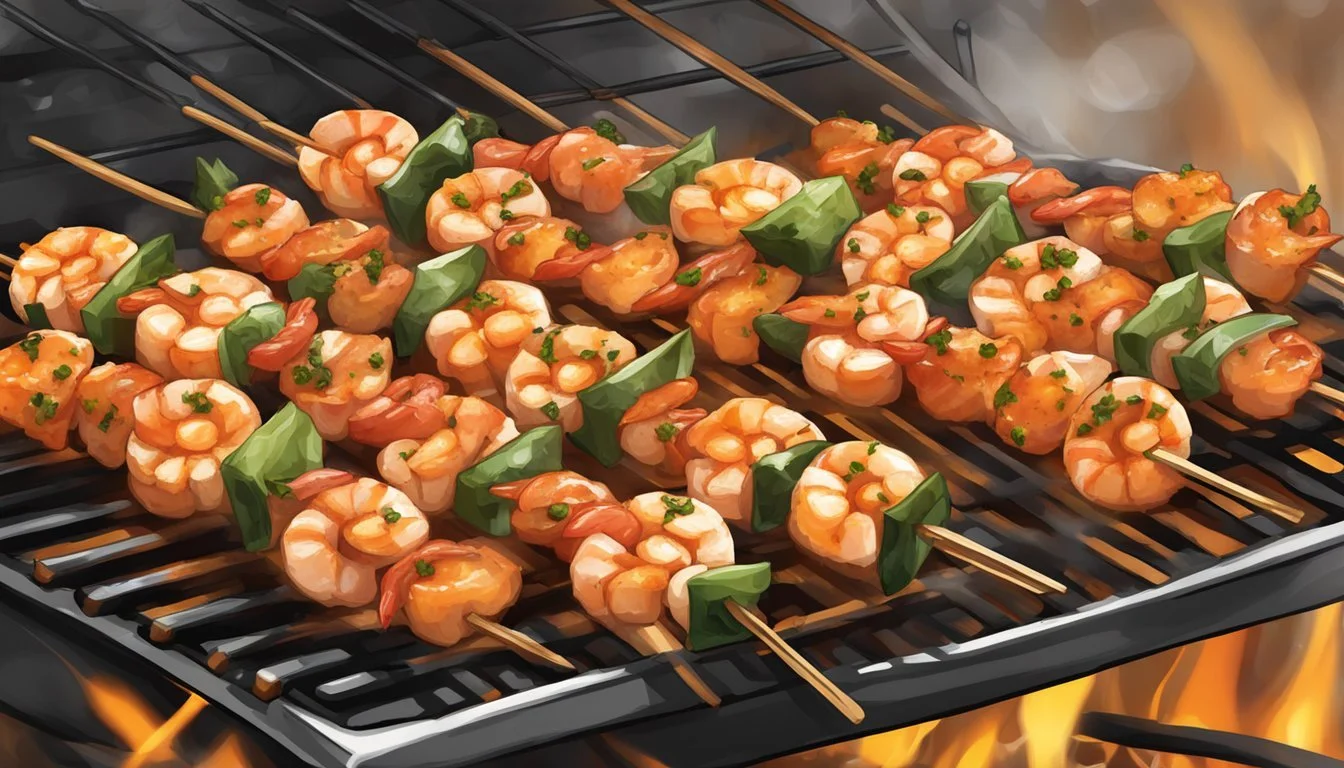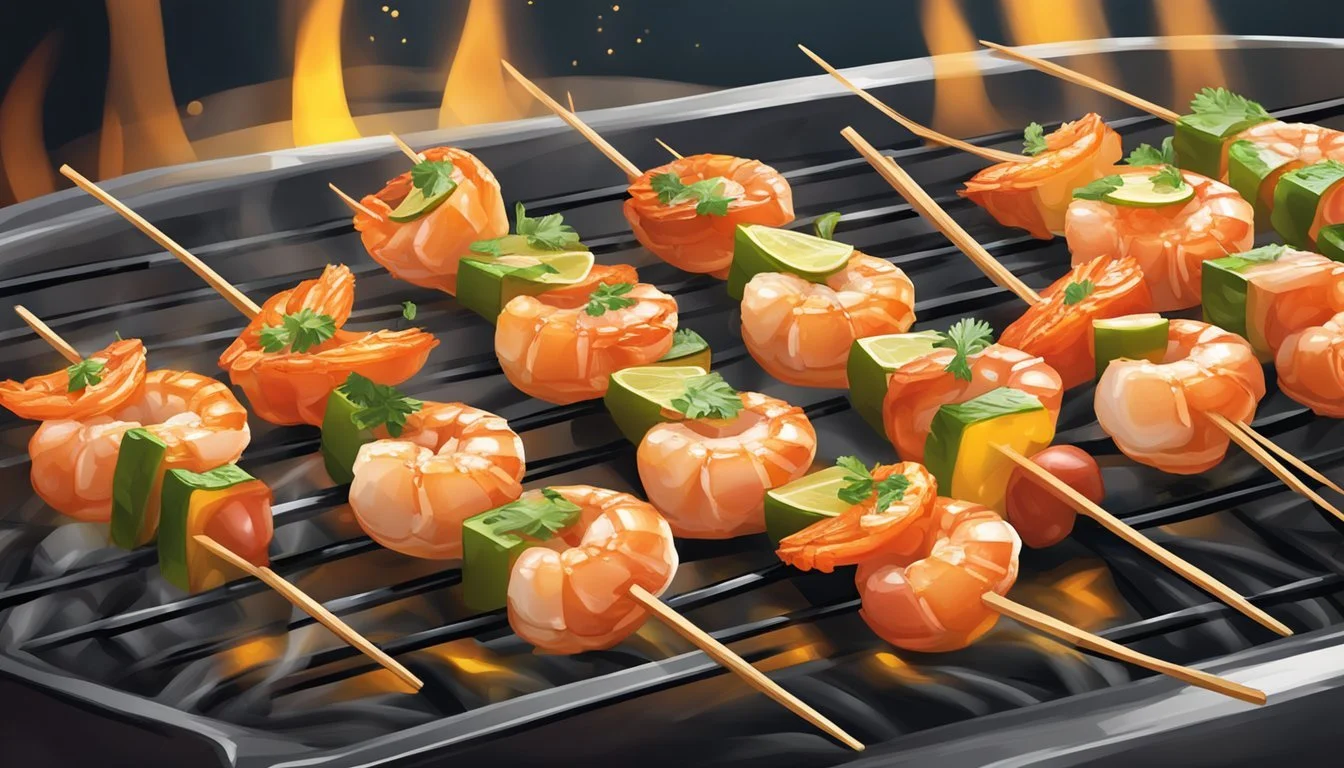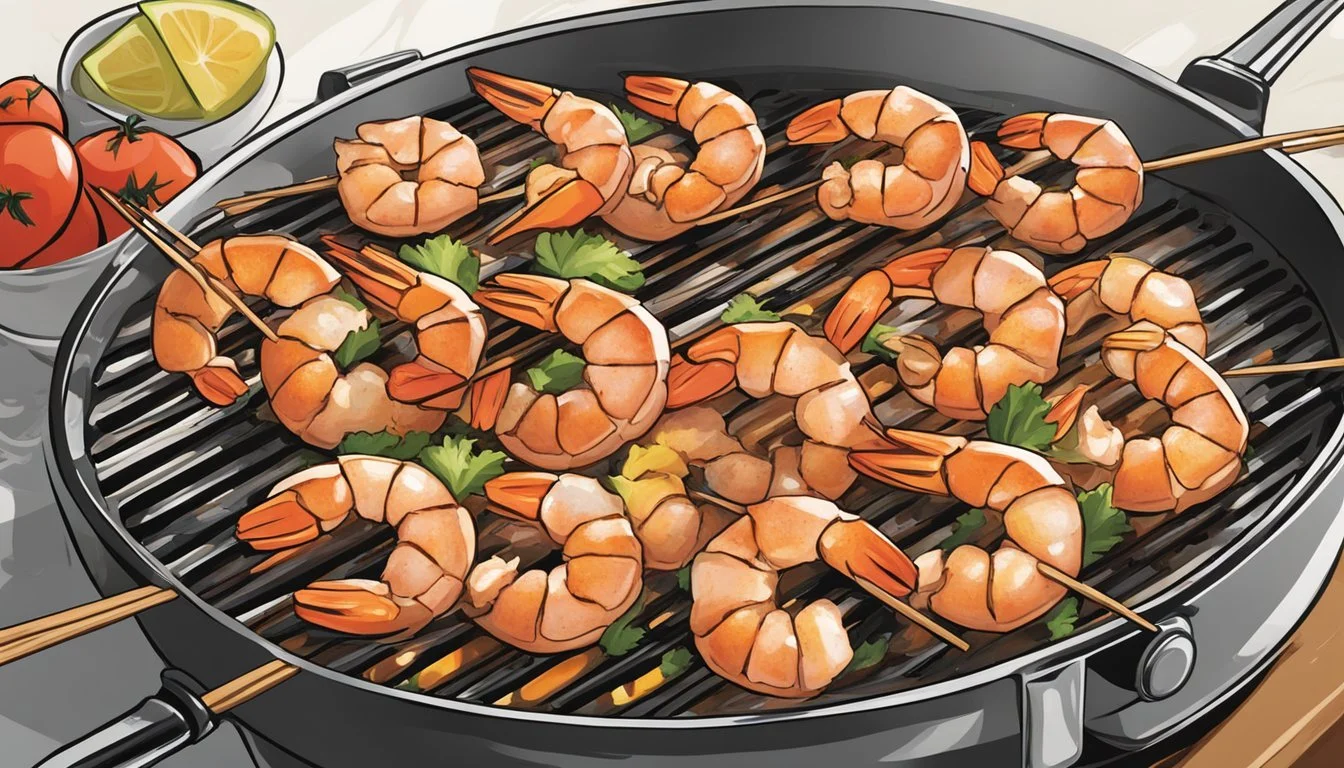Best Way to Reheat Shrimp Kabobs
Ensuring Juiciness and Flavor Retention
Shrimp kabobs make for a delicious and convenient meal that can be enjoyed fresh off the grill or reheated for a later feast. However, the process of reheating can often result in rubbery and overcooked shrimp if not done properly. To maintain the succulence and seasoning of shrimp kabobs, it is essential to employ methods that retain moisture and evenly reheat the seafood without cooking it further.
Reheating shrimp kabobs requires a gentle touch and the right technique to ensure that the flavors remain locked in, and the texture stays as close as possible to the original preparation. By using a combination of controlled heat and moisture-retaining methods, it's possible to revive shrimp kabobs to their juicy best. Careful attention to reheating will also preserve the well-seasoned crust often achieved from the marinade and spices used during the initial grilling.
Whether using an oven, skillet, or microwave, there are best practices to keep in mind that apply to each method, ensuring the shrimp kabobs heat through without losing their appetizing taste and texture. The key is to create an environment that allows for gentle reheating, using tools like foil and steam to help the shrimp retain their natural juices, and to reheat only until just warm, preventing the lean protein from becoming tough.
Understanding Shrimp Reheating Basics
When reheating shrimp kabobs, it's essential to maintain their juiciness and seasonings. Precise reheating methods can ensure that the seafood retains its texture and flavor, while food safety practices are crucial for preventing foodborne illnesses.
The Science of Reheating Seafood
Reheating shrimp involves applying heat to bring the cooked seafood back to an optimal temperature for consumption. Unlike reheating other proteins, shrimp must be heated gently to prevent them from becoming tough and rubbery. The goal is to warm them through while preserving their delicate texture. Gentle heat is key, and utilizing techniques, like steaming or using a skillet over low heat, can achieve this. The use of a splash of water or broth and covering the pan can trap moisture, ensuring the shrimp remain juicy.
Food Safety for Leftover Shrimp
Shrimp that have been cooked and stored properly can be safely reheated, but food safety guidelines must be strictly followed to minimize the risk of foodborne illness:
Cooling: Cooked shrimp should be cooled rapidly before refrigeration. They should not be left at room temperature for more than two hours, or one hour if the temperature is above 90°F (32°C).
Storing: Leftover shrimp should be stored in an airtight container and refrigerated within the appropriate time frame.
Reheating: The temperature must reach 165°F (74°C) to ensure any potential bacteria are destroyed.
For best results, leftover shrimp kabobs should be consumed within 1-2 days, and any signs of spoilage should be an immediate signal to discard them for safety reasons.
Preparing for Reheating
Before reheating shrimp kabobs, it's essential to ensure they are stored correctly and brought to an appropriate temperature. This preparation lays the groundwork for juicy, flavorful shrimp that are as close to their original state as possible.
Proper Storage Techniques
After enjoying a meal, any leftover shrimp should be stored promptly to maintain freshness. Shrimp kabobs should be placed in an airtight container to protect them from air exposure, which can lead to drying out and a loss of flavor. If a proper container is not available, wrapping them tightly in plastic wrap or aluminum foil is an acceptable alternative.
Bringing Shrimp to Room Temperature
Before reheating, the shrimp kabobs need to be brought to room temperature. This step is crucial as it ensures even reheating and helps to prevent the shrimp from becoming tough or overcooked. Shrimp should be taken out of the refrigerator and left on the countertop for about 10 to 15 minutes. Handling the shrimp kabobs carefully during this time is important as they can become delicate when not fully chilled.
Reheating on the Stove
Using the stove to reheat shrimp kabobs provides control over the heating intensity, which is key to preserving the shrimp's juiciness and seasoning.
Skillet Methods for Juicy Shrimp
The skillet method is preferred for reheating shrimp kabobs to maintain their juiciness. A nonstick skillet or frying pan is ideal to prevent sticking. Before adding the shrimp, preheat the skillet over medium heat with a small amount of olive oil which adds to the flavor and prevents drying out. Once heated, carefully place the shrimp kabobs in the skillet. It's important to perform regular stirring or flipping to ensure even reheating without overcooking.
Add shrimp kabobs to preheated skillet with olive oil.
Regularly turn kabobs for even heating.
Reheat until just warmed through, typically 2-3 minutes.
Maintaining Texture and Flavor
For optimal texture and flavor, reheating shrimp kabobs on the stove requires a delicate balance. Shrimp are prone to becoming rubbery when overcooked, so keep a close eye on them. The heat should be sufficient to warm the shrimp through without cooking them further. To keep the kabobs well-seasoned, avoid adding too much additional seasoning during reheating, as this can overpower the original flavors. Use a light touch if freshening up the seasoning, perhaps with a squeeze of lemon or a light drizzle of olive oil after heating.
Monitor heat to avoid overcooking.
Maintain original seasoning; add minimal extra seasoning if necessary.
Using the Microwave Wisely
When reheating shrimp kabobs in a microwave, the goal is to maintain their juiciness and seasoning. This requires attention to detail and the use of specific techniques to achieve the best results.
Microwave Reheating Tips
Time and Power: Reheat shrimp kabobs with a microwave set to a medium power level. One should use one-minute increments, checking the kabobs after each interval to avoid overcooking.
Use of Water: A splash of water added to the dish before microwaving helps to retain moisture in the shrimp. This prevents them from drying out and keeps them juicy.
Covering the Dish: It is advisable to cover the kabobs with a microwave-safe lid or damp paper towel. This method ensures even reheating and helps to lock in moisture.
Avoiding Spoilage: Before reheating, one must ensure the shrimp are not spoiled. Spoiled shrimp may have a bad odor, slimy texture, or an odd appearance.
Here is a quick reference table for the reheating process:
Step Action Purpose 1 Check shrimp Confirm they are good to eat 2 Splash water Add moisture 3 Cover properly Promote even heating 4 Reheat Use medium power, one-minute intervals 5 Observe Prevent overcooking
Alternative Reheating Methods
When reheating shrimp kabobs, maintaining juiciness and flavor is paramount. Here, we explore methods that ensure succulent results without compromising seasoning.
Grill Reheating Techniques
Reheating shrimp kabobs on a grill pan can closely replicate the texture and taste of the original grilled flavor. Instructions for grill pan reheating:
Preheat the grill pan on medium heat.
Lightly oil the pan to prevent sticking and retain the kabobs' moisture.
Place the shrimp kabobs on the pan, heating each side for about two minutes or until thoroughly warmed.
Innovative Air Fryer Use
The air fryer provides a rapid reheating technique that doesn't sacrifice the shrimp's tenderness. Guidelines for air fryer shrimp reheating:
For thawed shrimp kabobs, set the air fryer to 350°F.
Reheat for 3-4 minutes, checking halfway to ensure even heating.
Oven-Warming Strategies
The oven is an effective tool for reheating frozen shrimp kabobs without the need for prior thawing. Steps for oven-warming:
Preheat the oven to 350°F.
Arrange kabobs in a single layer on a baking sheet, and cover with foil.
Heat for 10-15 minutes, or until the shrimp are heated through.
Seasoning and Sauce Considerations
When reheating shrimp kabobs, one must ensure that the delicate balance of flavors is preserved. The existing seasoning should be complemented, not overpowered, and sauces should enhance rather than mask the shrimp's natural taste.
Avoiding Overpowering Spices
When reheating shrimp kabobs, it's crucial to consider the spices used in the original preparation. The goal is to maintain the integrity of the dish's flavor profile. Cajun seasoning, while robust when first applied, can become overwhelming if reapplied indiscriminately during reheating. Instead, one should assess the existing flavor and, if necessary, adjust with a light touch, possibly adding a squeeze of lemon to brighten the taste without overwhelming the palate.
Complementary Sauces for Reheated Shrimp
The sauce accompanying reheated shrimp kabobs should serve to enhance, not disguise, the shrimp's natural flavor. Here are ideal options:
Lemon-Garlic Butter Sauce: Combining melted butter with a hint of garlic and fresh lemon juice can create a sauce that complements the shrimp's taste without overpowering it.
Herb Infusions: Gentle herbs such as parsley or dill can be stirred into existing shrimp marinade for a fresh and subtle touch. These herbs pair well with the inherent sweetness of shrimp.
In both cases, the sauce should be drizzled lightly over the kabobs after reheating to ensure the shrimp remains juicy and well-seasoned.
Serving Reheated Shrimp
When reheated properly, shrimp can be a delightful centerpiece to a meal. It's key to pair them with complementary sides that enhance their flavor and texture, turning a simple reheat into a satisfying dish.
What to Serve with Grilled Shrimp
Reheated shrimp kabobs pair wonderfully with a variety of sides. A light salad offers a crisp and refreshing contrast, while a side of rice can absorb the rich flavors and provide a comforting base. Here are some specific pairings:
Salad: Opt for greens like arugula or spinach, dressed in a light vinaigrette.
Rice: Jasmine or basmati rice can complement the shrimp with their fragrant aroma.
Vegetables: Grilled asparagus or bell peppers can echo the charred notes of the kabobs.
Pairing Guidelines for Balanced Meals
To ensure the meal is balanced, consider the following guidelines:
Color: A vibrant mix of vegetables adds not only nutrition but also visual appeal.
Texture: Include a variety of textures - crunchy vegetables, fluffy rice, and juicy shrimp create a satisfying experience.
Flavor: Balance the shrimp's seasoning with sides that can contrast or enhance the main flavors, such as a squeeze of lemon juice on a salad or a sprinkle of herbs on rice.
Shrimp and Grits Specifics
When reheating shrimp and grits, retaining the dish's creamy texture and rich flavors is crucial. It is a beloved comfort food, with variations like Cajun shrimp and grits adding a spicy twist.
Reheating Shrimp and Grits
To effectively reheat shrimp and grits, one can opt for either the microwave or oven methods. Both methods require careful attention to moisture to prevent the grits from drying out and the shrimp from becoming tough.
Microwave Method:
Container: Place shrimp and grits in a microwave-safe container.
Covering: Loosely cover with a microwave-safe lid or plastic wrap.
Heating: Heat on medium power in one-minute intervals, stirring after each to maintain an even temperature.
Oven Method:
Oven Preheat: Set the oven to 350°F (175°C).
Dish Preparation: Add a bit of liquid to the grits and transfer to an oven-safe dish.
Covering: Securely cover the dish with a lid or aluminum foil.
Baking: Heat for 10-15 minutes, checking and stirring at half-time to ensure even warmth.
Recipe Variations and Enhancements
A range of recipe variations exist, with Cajun shrimp and grits being a distinguished option that brings a spicy kick to the dish. Enhancing flavor when reheating is possible with careful seasoning adjustments.
Cajun Shrimp and Grits:
Ingredients: Incorporate Cajun seasoning into the grits and generously sprinkle over the shrimp for an intensified flavor profile.
Process: During reheating, one might add a touch of cream or butter to the grits to preserve their creamy consistency.
Classic Enhancements:
Additions: Consider a pat of butter or a drizzle of cream to enrich the flavor and texture of the grits.
Seasoning: A pinch of salt or a sprinkle of fresh herbs can lift the flavors after reheating, making the dish taste freshly prepared.
Creative Use of Leftovers
Most often, reheating leftover shrimp kabobs directly can result in dryness or a loss of flavor. There are, however, innovative ways to repurpose these leftovers into delicious new meals for breakfast, lunch (What wine goes well with lunch?), or dinner that maintain the juiciness and seasoning of the shrimp.
Innovative Meal Ideas
Breakfast Options:
Shrimp Omelette: Beat some eggs and pour them into a skillet. Add pieces of leftover shrimp kabob, some diced vegetables, and a pinch of salmon seasoning to enhance the flavor.
Shrimp and Grits: Reheat the shrimp gently and serve over a bowl of creamy grits. Season with a bit of the original kabob marinade for added flavor.
Lunch Creations:
Shrimp Pesto Pasta: Remove the shrimp from the skewers and toss them with freshly cooked pasta and a dollop of pesto. This can be served warm or cold.
Shrimp Salad Wrap: Mix the leftover shrimp with a light dressing, wrap in a tortilla with greens, and pair with salmon seasoning for a quick and flavorful lunch.
Dinner Delights:
Shrimp Stir-Fry: Cut the shrimp into bite-sized pieces and stir-fry with vegetables like bell peppers and onions. Use the leftover kabob seasoning to flavor the dish.
Shrimp Kabob Pizza: Top a pizza base with pieces of shrimp kabob, add cheese, vegetables, and a little extra seasoning, then bake until crisp.
Using these techniques, one can transform leftover shrimp kabobs into a variety of savory dishes suitable for any meal of the day, ensuring that both the juiciness and the seasoning of the shrimp are preserved and enjoyed to their fullest.






